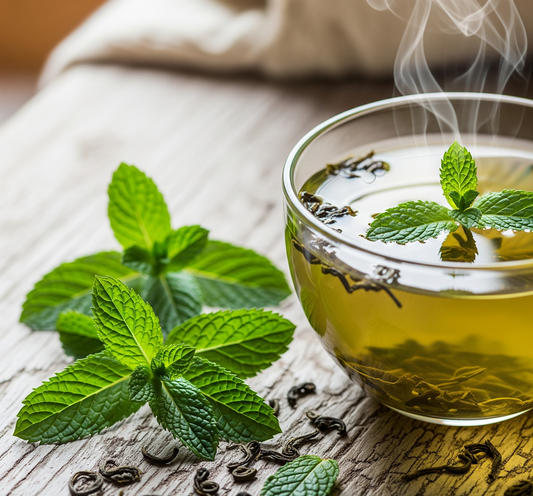As tea enthusiasts, we know that tasting tea goes beyond just sipping. It’s an art that engages all your senses, revealing the intricate flavors, aromas, and textures of each variety. By focusing on the sensory hierarchy—aroma, taste, mouthfeel, and aftertaste—you can enhance your appreciation and truly enjoy your favorite beverage.
As admirers of tea, this unique beverage holds a special place in our hearts and if we may say, a special place on our taste buds. But what if we told you that tasting tea involves much more than just taking a sip? Learning how to taste tea properly is a great way to enjoy your favorite drink on an even more intimate level. It’s an art form that engages all your senses, allowing you to explore the intricate flavors, aromas, and textures that each variety of tea has to offer.
Here we’ll walk you through the steps of properly and fully tasting tea, focusing on aroma, and flavor, and explain the concept of sensory hierarchy. Hopefully, by the end of the read, you'll be able to pick up on tea-tasting notes like a pro.
So without any further ado! Let's dive in!
The Basics of How to Taste Tea
Before we get into the nitty-gritty of the topic, let’s first break down the process of tea tasting. Just like wine tasting, it’s a multi-sensory experience. You’ll want to engage your sight, smell, and taste to fully appreciate the liquor in your cup. Paying close attention to the taste of tea, its texture, and aftertaste, allows you to uncover new layers of flavors and aromas.

To get things started, you’ll first want to prepare your tea properly. Make sure you follow the right steeping guidelines. The standard boiling water temperature for black tea is 210°F, 160°F for green and oolong tea, and 180°F for white tea. Similarly, the standard water temperature of herbal tea is 210°F.
Regardless of whether you're tasting green tea, white tea, oolong tea, or black tea, consistency is key. Consider using 2.5 grams of tea for every 5 ounces of water. Steep for about 3 to 4 minutes, depending on the type of tea.
Once your tea is ready, you can start the tasting process, which is made up of four key components: aroma, taste, mouthfeel, and aftertaste. These elements make up what is known as the “sensory hierarchy”, which we’ll explore step by step.
The Hierarchy of Taste
The hierarchy of taste in tea is structured for a reason. As you climb up the pyramid, the qualities that define a fine tea become more apparent. Aroma is the easiest characteristic to achieve, while a complex and lingering aftertaste is the most challenging. In simpler terms, many teas smell delightful, but only a few offer a rich and elegant aftertaste.
Each sip of tea includes aroma, taste, mouthfeel, and aftertaste. In high-quality teas, these elements are intricately developed. To enhance your tasting skills, try focusing on one element at a time. As you grow more comfortable identifying each aspect, you'll find it easier to connect them all.
1. Take in the Aroma: The First Step in Tasting Tea

Aroma is the first part of tea tasting and gives you your initial impressions of the tea. Smelling the tea before sipping it helps you get a sense of its depth. Follow these steps to fully experience the tea aroma:
- Smell the dry tea leaves before steeping them in hot water. This will give you clues about the tea's origin, freshness, and quality. For example, floral or fruity aromas often indicate a higher quality tea. White tea doesn’t technically expire, older teas tend to lose its fragrance over time.
Read more on: Does Tea Expire? Setting The Record Straight Once and for All
- After brewing the tea, take a couple of deep breaths and then smell the steeped leaves in the teapot. This will expose you to the rich aroma of the tea, showcasing many of the tea's hidden qualities.
- Finally, hold the cup close to your nose and take a long and deep breath. Focus on breathing through your nose while keeping your mouth closed. You might find the differences between the smell of the leaves and the tea in the cup to be quite significant.
Aroma is a quick way to detect the character of the tea notes that may be floral, earthy, or even sweet.
2. Taste of Tea: Break Down it’s Flavors
The second step after exploring the aroma is the taste of the tea. It is the core of any tea-tasting experience. This is where you can dive into the unique properties of the tea. But remember! Flavor isn't just about taking a sip. It's about using your entire mouth to pick up on subtle flavor notes.
Here’s how to get the most out of each sip:
- When tasting, take a loud, slurping sip. Why? Well! Slurping aerates the tea or in other words, introduces air into the liquor, mixing it with oxygen and enhancing its natural flavors. So don’t be shy—embrace the noise!
- Move the tea around your mouth. Don’t just let it rest in one place. Move your tongue from side to side and from front to back to let every part of your palate experience the tea.
- Focus on different flavor elements. Is the tea bitter, sweet, or astringent? Notice how the taste of tea changes from the initial sip to when it sits on your tongue.
Make sure to take your time. Tea can change with every brew, so don’t be surprised if the flavors become more pronounced or mellow as you drink.
3. Notice the Mouthfeel: Tea’s Texture in Your Mouth

The next step in learning how to taste tea properly is understanding mouthfeel. This process refers to the texture and weight of the tea on your tongue. Let us explain! Some teas feel thick and rich, while others feel light and mellow. Mouthfeel can tell you a lot about the tea's processing and overall quality.
Here’s how to evaluate mouthfeel:
- Pay attention to the weight of the tea. Does it feel dense? Is it heavy or light? This is an indication of its body.
- Next, check for texture. Does the tea feel smooth, or is it more chalky and coarse?
- Notice how it coats your mouth. Some teas feel oily, leaving a lingering sensation on your tongue and the roof of your mouth, while others feel clean and refreshing.
Mouthfeel is an essential part of taste analysis. It helps you distinguish between good-tasting teas and those that may not be as well-crafted.
4. Appreciate the Aftertaste: The Final Step
Aftertaste is an often overlooked step, but it’s still a crucial part of tea tasting. Aftertaste refers to the lingering flavor in your mouth after you’ve swallowed the tea. The longer and more pleasant the aftertaste, the better the quality of the tea.
Here’s how to evaluate the aftertaste:
- Once you’ve swallowed the tea, take note of how long the aftertaste lasts. A long-lasting aftertaste is a sign of a well-made tea.
- Next, focus on the flavors that linger. Do they transform or evolve, or do they disappear quickly?
- Pay close attention to the sensations. Some teas, especially herbal teas leave a refreshing, cooling sensation, while others leave a warm, spicy note.
Bonus Tasting Techniques: How to Get the Most from Your Tea
Now that you’ve understood how to taste tea, let’s get into some bonus tasting techniques that can come in handy in further enhancing your experience and unlocking even more layers of flavor and texture.
- Visual Assessment: You can learn a lot about a tea by simply looking at it. Set aside a small sample of unstriped dry leaves and check for clues. Are the tea leaves made up of uniformly sized particles or are they unevenly cut? Do you notice a high presence of buds or do you see lots of stems? While the former is a hallmark of quality tea, the latter is a common sign of low-quality tea that hasn’t been well sorted.
- Chewing: Swish the tea around in your mouth as if you're chewing it. This helps to release more of the tea's flavors and enhances mouthfeel.
- Retronasal Breathing: After swallowing the tea, gently exhale through your nose. This allows you to pick up on hidden tea notes that you may not notice when you first sip.
- Be Consistent: Use the same tea-to-water ratio and steeping time for every tea you taste. This allows for a reliable baseline for comparison.
- Avoid distractions: Find a quiet space while tea-tasting where you can focus solely on the tea and fully engage your senses.
- Taste at different temperatures: Let your tea cool slightly before tasting. Doing this keeps your tongue from burning. Some good-tasting teas also reveal more nuanced flavors as they cool down.
Tea tasting is a great way to unwind and appreciate the craftsmanship that goes into making your favorite beverage. By focusing on the sensory hierarchy —aroma, taste, mouthfeel, and aftertaste—you can deepen your appreciation for tea.
In conclusion, learning how to taste tea the proper way can transform your tea-drinking experience from a routine into a mindful practice. These steps will help you develop a deeper understanding of tea’s complexity and craftsmanship. Regardless of whether you’re drinking black, green, oolong, or white tea, pay attention to tea-tasting notes, and aroma. And aftertaste will further enhance your experience.
Just remember! Tea tasting is a journey and the more you practice, the better your palate will become at picking up subtle nuances of the tea notes. Happy sipping!




